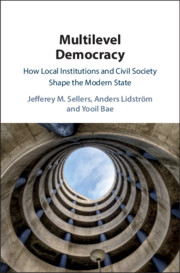Book contents
- Multilevel Democracy
- Multilevel Democracy
- Copyright page
- Epigraph
- Contents
- Figures
- Tables
- Acknowledgements
- Note on the Text
- 1 Introduction
- 2 Multilevel Democracy and the Modern State
- 3 Multilevel Democracies
- 4 Trajectories of Local State Formation
- 5 The Local State and the Formation of Civil Society
- 6 The Policy State and Local Governance
- 7 The Quality of Multilevel Democracy
- Postscript
- Appendix Cluster Analysis of Institutional Indicators
- References
- Index
4 - Trajectories of Local State Formation
Published online by Cambridge University Press: 11 February 2020
- Multilevel Democracy
- Multilevel Democracy
- Copyright page
- Epigraph
- Contents
- Figures
- Tables
- Acknowledgements
- Note on the Text
- 1 Introduction
- 2 Multilevel Democracy and the Modern State
- 3 Multilevel Democracies
- 4 Trajectories of Local State Formation
- 5 The Local State and the Formation of Civil Society
- 6 The Policy State and Local Governance
- 7 The Quality of Multilevel Democracy
- Postscript
- Appendix Cluster Analysis of Institutional Indicators
- References
- Index
Summary
Infrastructures of multilevel democracy are cumulative historical products. Their origins can date back to early state formation. Their institutional foundations were often laid before the arrival of mass democracy, national constitutional orders, state bureaucracies, or urban industrial society. Their formation and evolution has often followed distinct trajectories from national democratization, industrialization, and even the formation of national territorial states. For most of what are now developed democracies, the pivotal events took place over the long nineteenth century from the American Revolution to World War I. Over that period, throughout Europe, North America, and Japan, new national systems of local self-government and territorial administration at the scale of cities and communities established a local state. Introduced at the higher levels of states rather than localities themselves, enactments embedded into wider constitutional and administrative orders formalized a set of local institutions that had previously been informal or at best a patchwork, or had not existed before. In some instances this local state was the result of pressures from civil society. Other times it was the consequence of reform from above. Whatever its origins, this local state would shape the subsequent development of civic and political movements, and the emergence of the policy state.
- Type
- Chapter
- Information
- Multilevel DemocracyHow Local Institutions and Civil Society Shape the Modern State, pp. 119 - 201Publisher: Cambridge University PressPrint publication year: 2020
- 1
- Cited by

